An Introduction to Frederic Jouvenot
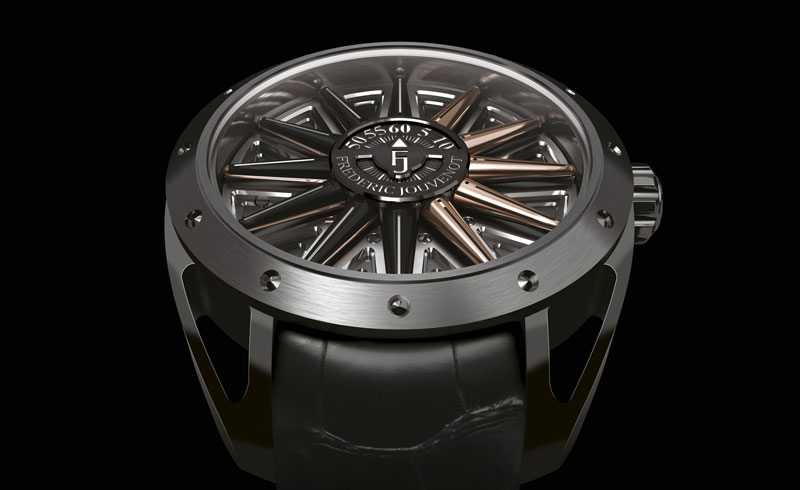
Following my recent articles covering young, but highly innovative brands such as HYT, Ludovic Ballouard, and Valbray, I turn my attention to somewhat of a rarity in the watch industry. A chap called Frédéric Jouvenot, creating the mystery tourbillon (a tourbillon lacking a hand) at just 27 years of age, has set up his eponymous manufacture in 2008.
Many capable watchmakers never accomplish what Frédéric Jouvenot has done in his relatively short lifespan thus far, so credits where credit’s due. Frédéric Jouvenot has created three very unique timepieces so far, all very different from traditional watch designs. His very first creation was the Automatic Chronograph Evolution or ACE in short, however he gained name and fame when he won the first GTE Superwatch Award in 2011 with the Helios.

Let’s first take a closer look at the Automatic Chronograph Evolution or short ACE (see image below). ACE features a chronograph movement, as the name suggests, but distinguishes itself from others by placing the rotor in front of the dial. You might wonder how you can still read the sub dials for the chronograph, but if you look closely you might spot that the rotor is specially crafted to fit around the sub dials. At least when it is right side up, or upside down, that is. When positioned on the left or right side of the dial, the small triangular-like aperture on the rotor allows some view on the sub dials, not to affect its usability too much.

The ACE features a classic column wheel chronograph, with the aforementioned oscillating weight in plain sight. The movement is housed in a case measuring 44 by 55 mm, available in a number of various materials like DLC-treated titanium, white gold or pink gold. There even is a frosted version, where the dial, bezel and rotor are set with diamonds.
Next in line is the Helios, part of the Solar Deity collection, a creation clearly inspired by the sun, the oldest mean of measuring time. The Helios is available in a wide variety of materials and iterations. Frédéric Jouvenot also caters the female connoisseurs with diamonds, bright colors, and an almost floral pattern on the dial, known as the Surya. The Surya measures a diameter of 42 mm, 2mm smaller then the other Solar Deity models: Helios, Inti or Amaterasu. All versions differ in detailing, decoration or color. The Inti is inspired by the Mayan pyramids in South Africa, and has a fully engraved bezel. For a complete impression of the entire Solar Deity range I recommend taking a look at Frédéric Jouvenot’s website.
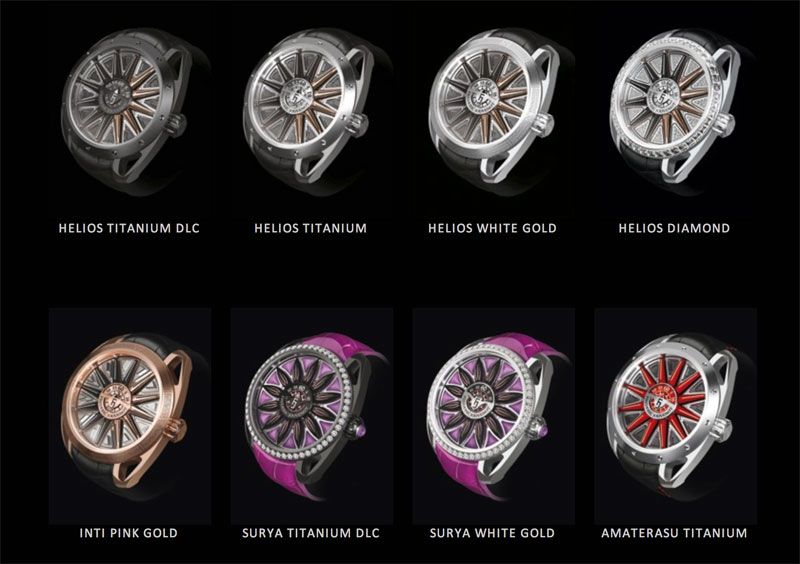
When it comes down to dials, that is exactly where the Solar Deity really sets itself apart from others, where it really shines you might say. The entire dial is designed around 12 cone-shaped markers. These markers all have a blackened side, and a colored side, mostly rose gold. Upon changing the hour, each marker flips to the corresponding side, where midnight is indicated by all black markers and high noon with all gold (depending on what color is on the other side of course).
These cone-hour-indicators make the Helios into a very practical 24-hour watch and the rotating cones create a very interesting display, 24 times a day. The Solar Deity grabbed the SuperWatch-award at the 2011 Geneva Time Exhibition, which is a formidable acknowledgement of the craftsmanship surrounding this timepiece.
All models in the Solar Deity collection are limited editions of 18, 88 or 188 pieces and prices start at CHF 49,860 for the titanium versions, like this Helios Titanium.
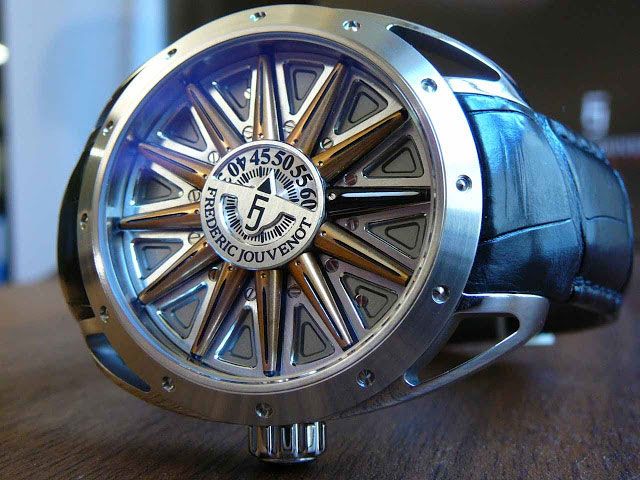
The latest, recently released spawn from Frédéric Jouvenot’s capable hands is the Tour de Force. An intricately designed timepiece, packing a world’s first. The Tour de Force indicates the power reserve through a number of discs, showing just how many minutes of power the watch has left. This complication is christened the Numerical Power Reserve, and packs a great deal of presence.
We have seen a wide range of power reserve indicators in the past, the most common of which use a small hand travelling along an arc, often stylized like some sort of gauge, or displayed in hours or even days. The Power Reserve indicator in the Tour de Force however, is totally different!
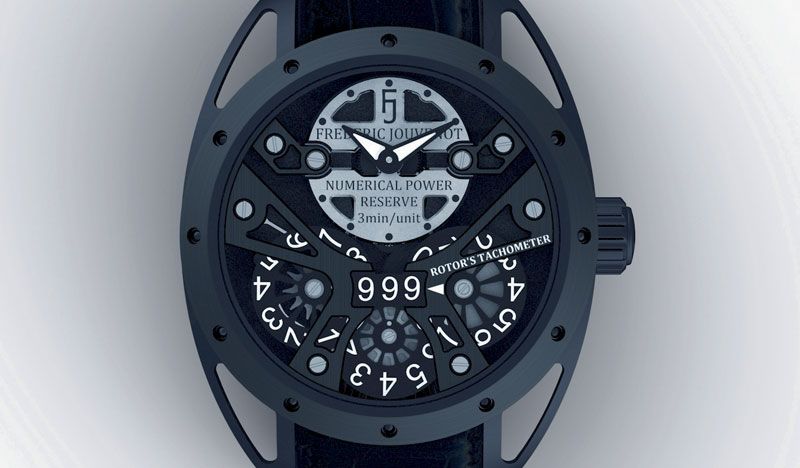
Three discs, placed on the dial side of the watch, tell you exactly what you need to know: What’s the power inside my watch to a precision of roughly three minutes? The discs indicate this almost like a date window usually does. Multiple discs interline to display the required number. The key to ‘reading’ the power is that for every digit the display shows, three minutes of power is available. When the movement isn’t wound, the indicator shows “000”. When the rotor has done a single revolution, it will display “001”. The more the rotor moves around, the higher the number will be. The discs will turn in synch with the rotor, so when you really crank it, the number corresponding with the amount of power will increase quickly. When the movement is on full charge, but not worn, the indicator will slowly count down from “999” to “000”.
Sounds logical, right? In total, the complication can display up to 999 units of power, each measures out to 3 minutes, which equals almost 50 hours. The power reserve doesn’t compete with a Rebellion T1000 for instance, but 50 hours is acceptable isn’t it?
The funny thing is, when you look closely at the three dials, each dials has the numbers printed in a different position, twice vertical, once horizontal. Frédéric Jouvenot had to design it in such a way all three digits lined up perfectly. Just a funny little thing, not the hardest challenge to overcome, but clearly visible when looking at the dial. The design and layout of the dial, forces the hour and minutes into the upper part of it. It is displayed at 12 o’clock, with a small hour and minute indicator. The time indication has a small sub dial like plate behind the markers, displaying the logo, full brand name, “Numerical Power Reserve” and “3min/unit” engraved on it so there is a lot going on here. There are also a number of indicators usable as hour markers, to tell time a little easier.
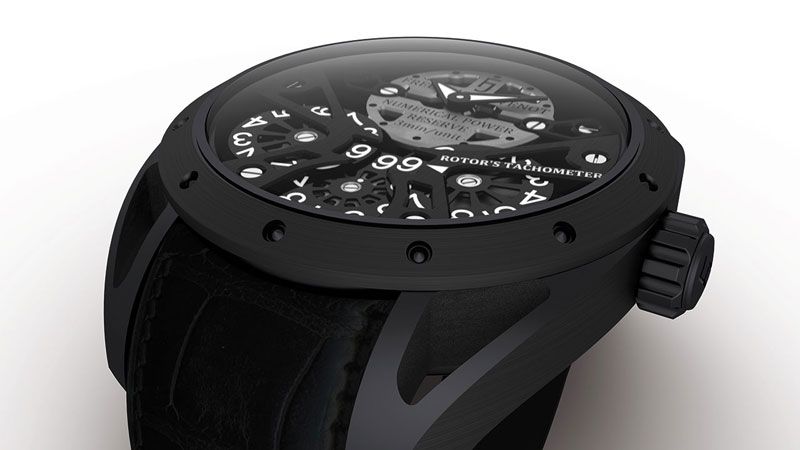
The layout of the dial is truly focused on the new complication. All in all there is a serious amount of markings on the dial, which could give it a cluttered look very quickly. The use of white on black, with a hint of steel detailing helps legibility big time though.
When we take a look at the case, it can be distinguished as Frédéric Jouvenot’s signature design by now. It follows along the same path as the ACE and the Solar Deity, with open worked and slightly curved lugs for a comfortable and snug fit on the wrist. The titanium case is treated with a black DLC-coating, and measures 44mm in width. Strap-wise, it comes on a black alligator strap with a folding clasp, also in black DLC. Sapphire crystal on both front and back of the case is anti-reflective, and the backside will be numbered. Sadly, there is no image of the back of the case available yet so I am unable to take on a journey into the movement. The Tour de Force will be available somewhere in 2013, and we will make sure to follow Frédéric Jouvenots every move.
For more information on Frédéric Jouvenot and his creations, visit their website or Facebook-page.
This article is written by Robin Nooij, contributing writer for Monochrome Watches.




1 response
The article is great introducing the brand.
Now, me comments is regarding what I think is a typo. In paragraph four, the sentence: “The Inti is inspired by the Mayan pyramids in South Africa”
It should be “South America”… though Mayans actually roamed Central America more than the South part.